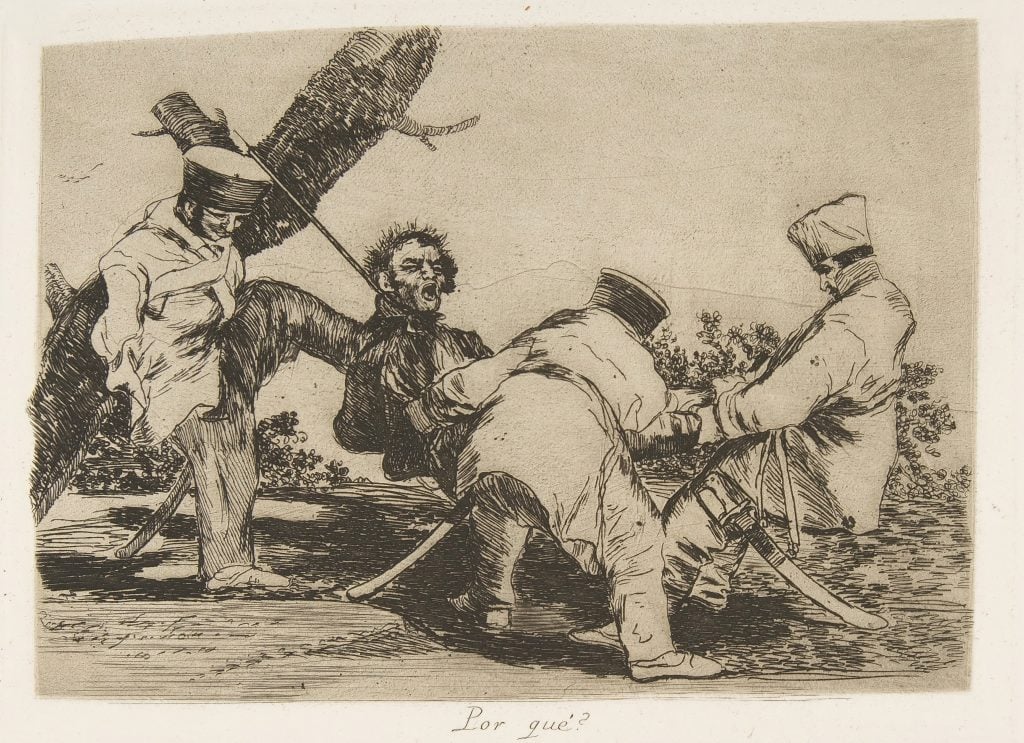Law & Politics
Speculation Grows Over a $4.7 Million Tax Bill That Was Paid Off With Mystery Goyas
The Spanish press has raised questions about the inflated valuation of the works.

The Spanish press has raised questions about the inflated valuation of the works.

Jo Lawson-Tancred

A trove of valuable paintings by famous Old Master artists like Francisco Goya and Francisco de Zurbarán worth over €4 million ($4.3 million) has been used to pay off a tax bill of €4.3 million ($4.7 million) owed to the local government of Álava in Spain’s Basque Country. The identity of the indebted individual was undisclosed, leading to speculation about the origin of the collection.
Among the artworks paid in kind are some 200 etchings by Goya, including original copies from his Disasters of War, Disparates, Los proverbios, and Caprichos series. Additionally, the Álava Treasury received around 85 paintings, including one of the Virgin Mary attributed to de Zurbarán, a triptych of the Spanish Civil War by Modernist Aurelio Arteta, and several more paintings by another 20th-century artist Ignacio Diaz de Olano.
These works amounted to about 20 percent of all income tax taken in Álava in 2022, according to el Diario, which first reported the news. Despite the supposedly confidential arrangement, public records suggest that the entire collection can be traced to the Celaya Foundation, which oversees the estate of Juan Celaya, a local businessman who died in 2016.
The foundation itself does not owe any tax, so it is not clear who took possession of these works and subsequently defaulted on their tax payments. El Diario has suggested that the in-kind payment may be related to debts owed by the battery manufacturer Cegasa, which was founded by Juan Celaya in 1934. However, that company still owed €1.3 million ($1.4 million) in tax in 2023.
The Álava Treasury did not immediately respond to a request for comment.
What’s more, the most important works were already effectively part of public heritage. The prized Goya etchings were lent to the local museum of fine arts in 2018 and the Arteta triptych was loaned to the Guggenheim Bilbao in 2021.
The Spanish paper has drawn attention to the inflated valuations attached to some of the works. Together, the Goya etchings received an insurance valuation of €191,000 ($207,000) in 2018 before they were loaned out; now they are said to be worth €1.5 million ($1.6 million). Meanwhile, the Arteta triptych has been valued at €1.2 million ($1.3 million), an increase of €200,000 ($217,000) since 2018. The resulting figures bring the total value of the collection closely in line with the amount of tax owed.
When pressed about the price markup, the Álava Treasury told el Diario that the initial report from 2018 had only been an estimate rather than an official appraisal, although those figures were used to insure the works for public exhibition. The political opposition EH Bildu has filed a complaint about the lack of transparency surrounding the agreement to accept the works, the most important selection of which was once valued €2.3 million ($2.5 million), as an in kind payment for a $4.3 million ($4.7 million) tax bill.
A treasury spokesperson has stated in the Spanish press that accepting cultural heritage in lieu of money to clear a tax bill is perfectly legal. It is also not subject to a wealth tax. Spain is not the only country that accepts this form of payment. In the U.K., art is often donated to the state as a means of covering inheritance tax.